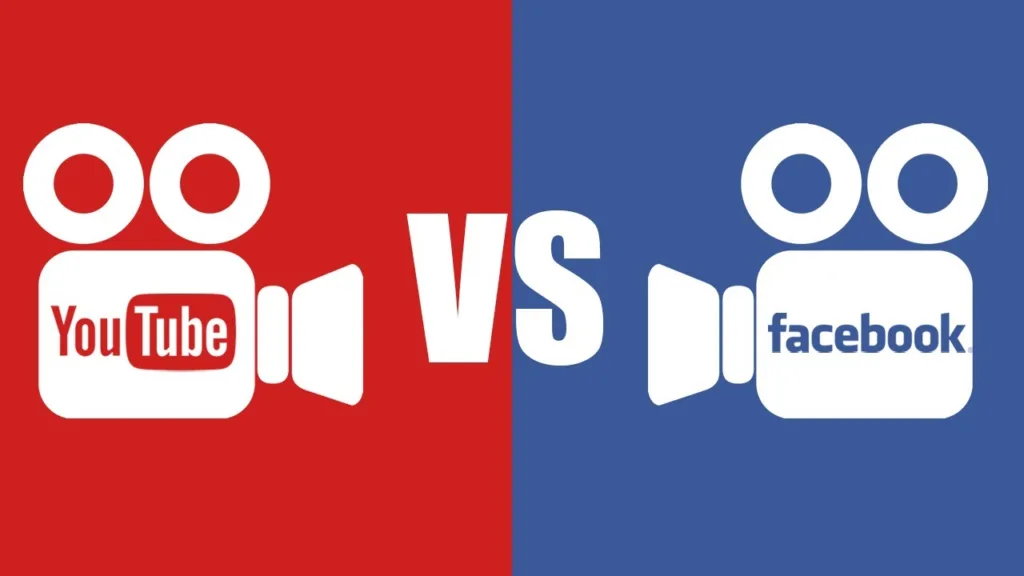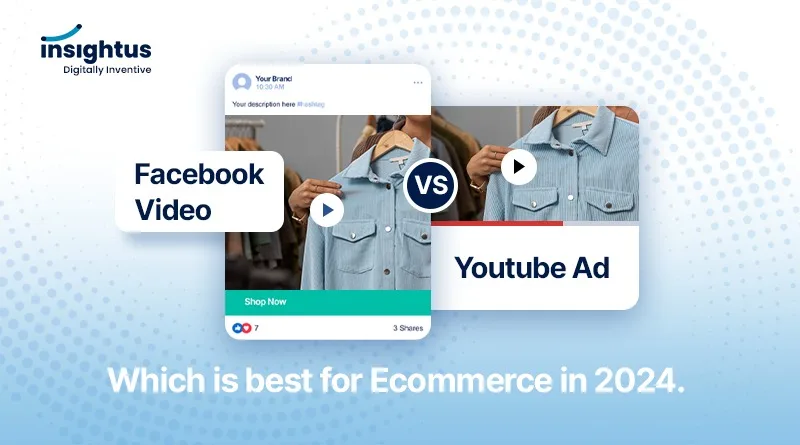Video ads are exploding in the e-commerce business, captivating audiences and driving sales. But with two powerhouse platforms – Facebook and YouTube – vying for ad dollars, the question arises: which platform reigns supreme for reaching your target customers and boosting your bottom line?
This blog is a Facebook vs. YouTube video ad showdown, analyzing key factors like reach, format, targeting, cost, and campaign goals to equip you with the knowledge to make an informed decision for your e-commerce business.
Get ready to know:
I. Introduction
II. Platform Comparison:
- Reach & Audience:
- Facebook: Huge user base, detailed targeting options, but potentially passive audience.
- YouTube: Focused audience actively seeking content, potential for virality, younger demographics.
- Ad Formats & Features:
- Facebook: Shorter, mobile-friendly formats, interactive elements like polls and quizzes, carousel ads.
- YouTube: Longer, immersive formats, skippable ads, mid-roll and pre-roll placements, TrueView options.
- Targeting & Retargeting:
- Facebook: Powerful interest-based and demographic targeting, custom audiences, retargeting based on website visits.
- YouTube: Keyword and channel targeting, contextual targeting based on video content, retargeting based on watch history.
- Cost & ROI:
- Facebook: Generally lower cost per view (CPV), but competitive landscape impacting costs.
- YouTube: Higher CPV initially, but potential for organic reach and longer engagement leading to higher ROI.
III. Choosing the Right Platform for Your Needs:
- Product Type: High-consideration products may do better with longer YouTube demos, while impulse purchases might thrive on Facebook’s quick format.
- Target Audience: Consider where your ideal customer spends their time online and what type of content they consume.
- Budget & Goals: Analyze the cost-effectiveness of each platform based on your budget and campaign goals.
- Creative Strategy: Video style, messaging, and tone need to align with the chosen platform’s audience and format.
IV. Tips for Success with Video Ads:
- Compelling Storytelling: Focus on emotional connection and problem-solving through video content.
- High-Quality Production: Invest in professional visuals and audio for maximum impact.
- Clear Call to Action: Tell viewers exactly what you want them to do after watching the ad.
- A/B Testing & Optimization: Continuously test different formats, audiences, and creatives to find what works best.
V. Conclusion
VI. Case Studies
Reach & Audience:

Image credit: google.com
Facebook: With over 2.91 billion monthly active users, Facebook boasts a staggering reach. Its robust ad targeting options, based on demographics, interests, and behaviors, allow you to pinpoint your ideal customer with laser precision. This is what worked for shoe brand Allbirds: they targeted Facebook users who showed interest in outdoor activities and sustainability, leading to a 40% increase in online sales.
However, with such a vast audience, attention spans can be limited. Facebook users often scroll through their feeds passively, meaning your ad needs to be instantly captivating to grab their attention.
YouTube: While its user base pales in comparison to Facebook (2.5 billion monthly active users), YouTube offers a different kind of reach. Its audience is actively engaged, seeking out specific content or entertainment. This creates fertile ground for product demonstrations, educational videos, and storytelling that resonates deeply. A prime example is Dollar Shave Club, whose viral YouTube ad campaign catapulted them to fame and fortune by targeting men looking for convenient grooming solutions.
However, targeting on YouTube can be broader, focusing on keywords, channels, and video content. While potent for brand awareness and virality, reaching a highly specific audience segment might be more challenging.
Capturing Attention on Facebook and YouTube

Image credit: google.com
Facebook: Forget lengthy epics, here’s where bite-sized brilliance shines. Facebook video ads thrive on short, mobile-friendly formats that hook viewers fast. Think captivating product demos under 15 seconds, eye-catching images with carousel ads showcasing multiple products, and interactive elements like polls and quizzes that turn passive viewers into active participants. Take Casper mattresses, for example. Their Facebook video ads featuring quick naps and celebrity cameos saw a 30% lift in brand awareness and website traffic.
But brevity isn’t the only trick in Facebook’s pocket. Story ads allow you to weave an immersive narrative within the familiar flow of Stories, while live-stream shopping events let you connect directly with potential customers in real-time.
YouTube: Brace yourself for deeper dives. YouTube, the home of long-form content, caters to viewers seeking in-depth explorations. Here, you can mesmerize with product tutorials spanning several minutes, tell your brand story through captivating narratives, or showcase testimonials from real customers. Beauty brand Glossier leveraged this power, crafting long-form YouTube tutorials featuring influencers, resulting in a 20% increase in sales for their featured products.
However, attention spans aren’t limitless. YouTube offers skippable ads for pre-roll and mid-roll placements, allowing viewers to control their experience. Additionally, TrueView options let viewers only pay for ads watched to completion, making your budget go further on engaged audiences.
The Takeaway: Both platforms offer diverse formats to fit your goals. Facebook’s mobile-first approach with interactive elements is ideal for quick bursts of inspiration and driving immediate action. YouTube’s focus on immersive storytelling and longer formats fosters deeper engagement and brand loyalty. Choosing the right format hinges on your product, target audience, and the desired customer journey.
Reaching Your Ideal Customer on Facebook and YouTube

Image credit: google.com
Targeting the right audience is the Holy Grail of video ad success. Both Facebook and YouTube offer powerful tools to ensure your message reaches the perfect customers for your brand.
Facebook’s Instruments:
- Laser-Focused Targeting: Drill down to your ideal customer based on demographics, interests, behaviours, and even life events. Target fitness enthusiasts, recent homebuyers, or people who follow your competitors for maximum impact.
- Custom Audiences: Upload your customer lists or website visitors for hyper-personalized ad experiences. Retarget those who abandoned carts or remind previous customers about new products they might love.
- Lookalike Audiences: Expand your reach by finding new users who share similar characteristics with your existing customers or high-value segments.
YouTube’s precision:
- Keyword Mastery: Target viewers searching for specific products, terms, or even your competitors’ brands. Dominate relevant searches and capture customers at the peak of their buying intent.
- Channel Targeting: Place your ads on specific YouTube channels your ideal audience frequents. Immerse yourself in communities where your brand resonates and build trust with relevant viewers.
- Contextual Targeting: Let YouTube’s AI automatically match your ads to videos based on their content and theme. Reach viewers already engaged with topics relevant to your product, ensuring perfect context for your message.
- Watch History Retargeting: Re-engage viewers who interacted with your previous YouTube videos or similar content. Keep your brand top-of-mind and nudge them down the conversion funnel.
The Verdict: Both platforms offer sophisticated targeting options, but their strengths differ. Facebook excels at pinpoint precision based on demographics and website behaviour, while YouTube shines in reaching viewers actively seeking relevant content or similar channels. Ultimately, the winning strategy depends on your product, audience, and campaign goals.
Cost & ROI on Facebook and YouTube

Image credit: google.com
Budgeting for video ads takes a keen eye, and understanding the cost dynamics of Facebook and YouTube is crucial for maximizing your return on investment (ROI).
Facebook’s affordability edge: Generally, Facebook boasts a lower cost per view (CPV) compared to YouTube. This means reaching a large audience can be relatively inexpensive, making it attractive for brands on a tight budget. However, the playing field isn’t level. Facebook’s hyper-competitive ad landscape can drive up costs for popular keywords and audiences, requiring constant budget adjustments to maintain visibility.
YouTube’s long-term play: While YouTube’s initial CPV tends to be higher, its potential for organic reach and longer viewer engagement can translate into a higher ROI in the long run. Engaging videos can spark organic viewership, boosting reach and brand awareness for free. Additionally, viewers who invest time in watching longer videos are more likely to be genuinely interested in your product, leading to higher conversion rates and a better return on your ad spend.
Cost is just one piece of the puzzle. Consider your campaign goals. If immediate action and traffic spikes are your priority, Facebook’s lower CPV might be ideal. But for building brand loyalty, fostering deeper engagement, and driving long-term sales, YouTube’s potential for organic reach and higher conversion rates could offer a better ROI.
The Winning Formula: Don’t get blinded by numbers. Experiment with both platforms, track your results, and refine your strategies. Test different formats, audiences, and targeting options to find the sweet spot where cost meets engagement and your ROI soars.
Targeting is an ongoing process. A/B test different options, analyze data, and refine your approach to keep your ads hitting the bullseye with unwavering accuracy.
Choosing the Right Platform for Your E-commerce Video Ads

Image credit: google.com
So, you’ve weighed the pros and cons of Facebook and YouTube – now it’s decision time! But selecting the perfect platform isn’t a one-size-fits-all game. It’s a strategic dance based on your unique needs and goals. Let’s break down the factors to consider for a winning choice:
Product Powerhouse:
- High-Consideration Products: Complex purchases that require research and comparison, like furniture or electronics, excel with YouTube’s long-form demos and in-depth storytelling.
- Impulse Buys: For quick decisions like trendy accessories or snacks, Facebook’s bite-sized videos and interactive elements can trigger instant action.
Audience:
- Know Your Tribe: Where does your ideal customer hang out online? Are they scrolling Facebook feeds or actively searching YouTube for solutions? Targeting the platform they frequent is key.
- Content Cravings: Consider the type of content your audience consumes. Do they favour quick, dynamic snippets or prefer immersive narratives? Align your video format to their viewing habits.
Budgeting:
- Stretch Your Dollars: Facebook generally offers a lower CPV, making it attractive for budget-conscious campaigns. However, YouTube’s potential for organic reach and higher conversion rates can lead to greater long-term ROI.
- Goals Guide the Game: Are you aiming for immediate conversions or building brand loyalty? Facebook’s fast reach excels at the former, while YouTube’s deeper engagement is a champion for the latter. Choose the platform that aligns with your goals and optimizes your budget.
Creative Canvas:
- Style and Story: Adapt your video style, messaging, and tone to the platform’s audience and format. Facebook thrives on fast-paced visuals and catchy hooks, while YouTube calls for a more personal and informative approach.
- Consistency is Key: Maintain a consistent brand voice and visual identity across both platforms for seamless recognition and trust.
There’s no single victor in this platform battle. Each holds unique strengths for maximizing your e-commerce video ad potential. Analyze your product, audience, budget, and goals, then blend Facebook’s reach and agility with YouTube’s engagement and storytelling to craft a winning video ad strategy that dominates.
Remember: Both platforms possess unique strengths. Facebook’s massive reach and laser-focused targeting can drive broad awareness and conversions. YouTube’s engaged audience and potential for virality can build brand loyalty and long-term customer relationships. Ultimately, the optimal choice depends on your specific goals and target audience.
Facebook vs. YouTube Video Ad Real World Case Studies You Must Check Out

Image credit: google.com
Facebook:
- Casper Mattress: Short, eye-catching Facebook video ads featuring celebrity cameos and quick naps led to a 30% increase in brand awareness and website traffic.
- Search link: https://www.youtube.com/watch?v=nMwJf7eluN8
- Allbirds Shoe Brand: Facebook video ads targeting users interested in outdoor activities and sustainability resulted in a 40% rise in online sales.
- Dollar Shave Club: A Viral YouTube ad campaign targeting men seeking convenient grooming solutions catapulted them to fame and fortune.
- Search link: https://www.youtube.com/watch?v=PepiLdBIfSc
- Glossier Beauty Brand: Long-form YouTube tutorials featuring influencers led to a 20% increase in sales for featured products.
- Search link: https://www.youtube.com/watch?v=b7CTyxBeTC8
YouTube:
- Lululemon Athleisure Brand: YouTube ad campaign showcasing real customers and diverse body types using their products fostered authenticity and drove brand loyalty.
- Search link: https://m.youtube.com/watch?v=ORaWH_e7Uk0
- Dollar Shave Club: Follow-up YouTube ad campaigns built on the initial viral success with humor and brand storytelling, further solidifying their market position.
- Search link: https://www.youtube.com/watch?v=ZUQjN7vkB3M
- Peloton Exercise Bike: YouTube ads featuring user testimonials and real-life workout experiences built trust and brand affinity, contributing to their sales boom.
- Search link: https://www.youtube.com/watch?v=d6zg6dvqbOw
- Away Luggage Brand: YouTube ad campaign highlighting the emotional aspects of travel and connection resonated with viewers, leading to increased brand awareness and conversions.
- Search link: https://www.youtube.com/watch?v=vKZ4wI19STE
Comparison Articles:
- Facebook Ads vs YouTube Ads in 2023: https://www.entrepreneur.com/growing-a-business/youtube-vs-facebook-ads-which-is-better-heres-your/450880
- Battle of Video: Facebook vs. YouTube Ads: https://improvado.io/integrations/facebook-ads
- YouTube Ads vs Facebook Ads (We Spent $1500000 Testing Both!!): https://www.entrepreneur.com/growing-a-business/youtube-vs-facebook-ads-which-is-better-heres-your/450880
These are just a few examples. Use these search links as a springboard to discover more real-world video campaigns for both Facebook and YouTube. Analyze the results, pay attention to the target audience, video format, and messaging, and learn from their successes and challenges to craft your own winning video ad strategy.
Embrace short-form video: Facebook prioritizes Reels and short-form video ads. Think engaging snippets under 15 seconds to grab attention and drive instant action.
Personalize and target like a pro: Leverage Facebook’s powerful targeting options to reach your ideal customers with laser precision. Consider demographics, interests, behaviors, and even life events for hyper-relevant ad delivery.
Shop the feed: Facebook is pushing in-feed shopping experiences. Utilize features like product catalogs, shoppable posts, and live video commerce to make buying seamless within the platform.
Go omnichannel: Integrate your Facebook ads with other marketing channels for a cohesive brand experience. Retarget website visitors, promote cross-channel offers, and track performance across platforms.
Prioritize privacy-first approach: Adapt your ad strategies to evolving privacy regulations. Focus on first-party data, contextual targeting, and building trust with your audience.
Experiment and stay agile: The Facebook ad landscape is constantly evolving. Test different formats, audiences, and targeting options to find what works best for your brand and stay ahead of the curve.
Facebook: Ideal for broad reach, fast conversions, and short-form video engagement. Think impulse buys, quick awareness campaigns, and interactive formats.
YouTube: Perfect for deeper engagement, brand storytelling, and longer-form content. Great for high-consideration products, building loyalty, and organic reach through compelling videos.
Ultimately, the best platform depends on your goals, target audience, and product. Analyze factors like budget, video type, and desired customer journey to choose the platform that amplifies your message and drives optimal results.
Don’t be afraid to experiment and utilize both platforms strategically for a winning e-commerce video ad strategy.


